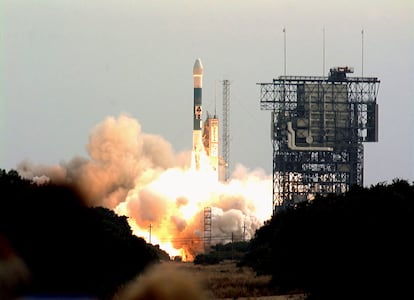A chain of Mars exploration catastrophes: When NASA confused the metric with the imperial system
In this excerpt from his book, journalist Rafael Clemente recounts the amazing history of space exploration

The 1990s were a disastrous decade for Mars exploration projects. Out of seven attempts, only two were successful. And the apparent ease of Viking 1 and 2 — a pair of NASA landers and orbiters — hid a more difficult reality: landing on the red planet was much more difficult than it seemed. In the first 50 years of exploring Mars, almost half of the vehicles sent there crashed or stopped working.
In September 1992, NASA launched its Mars Observer, a platform that was meant to continue and expand the studies carried out by the Viking orbiters. It was a newly-designed vehicle, the first of a class intended to make planetary visits not only to Mars, but also — in the future and with the necessary adaptations — to Venus, or even Mercury.
It was built from a standard structure typical of conventional communications satellites. It seemed like a good idea from the point of view of taking advantage of already proven designs, but in the end, it wasn’t. Some of its components — which had worked well for weeks around the Earth — wouldn’t be able to withstand the rigors of a months-long trip to much colder environments.
When the Mars Observer was only a couple of days away from reaching its target, it was given the order to pressurize its tanks in preparation for braking. It’s unclear exactly what happened: suspicion points to a slight leak of oxidizer (nitrogen tetroxide) from a valve. Even though it was a small amount over the course of an 11-month-long flight, the corrosive liquid would have built up in the pipes. Hence, when a second set of valves opened, it could have come into contact with the fuel, causing an explosion. This is just one of several hypotheses, but the sudden failure of communications didn’t allow for a definitive conclusion to be reached.
The Mars Global Surveyor (MGS) — another probe launched four years later — had better luck. Following the failure of the Observer, the idea of using a type of spacecraft that would be of use to all missions had already been abandoned. This was a new design, specifically built for operating on Mars: the scientific instruments it carried were almost identical to those that had been lost in the previous attempt. The relative positions of Earth and Mars made the journey a long one: 11 months. The trip culminated with the vessel’s entry into a heavily-elongated orbit, whose altitude would be reduced until it became circular at a level of only 142 miles above Mars. The adjustment took another year-and-a-half because, for the first time, solar panels (rather than chemical engines) were used as air brakes. There were also two steerable fins, strong enough to withstand repeated friction from the upper layers of the atmosphere.
In the end, the Global Surveyor was placed in a sun-synchronous orbit, calculated in such a way that it passed over the same terrain feature at the same solar time. The lighting conditions were similar and the shadows — always identical — made it easy to detect changes in the landscape.
Although projected with a useful life of only two years, the MGS received repeated mission extensions (that is, budget allocations), which kept it active for almost 10 years. This was longer than any other spacecraft sent to Mars until then. During that time, it obtained a quarter-of-a-million images, as well as detailed altimetric coverage of the planet. This information would prove to be of great help in preparing for future operations taken by the mobile robots that were about to be completed.
By November 1996, the Soviet Union had ceased to exist. Mars 8 was intended to be the first deep-space probe to fly the Russian tricolor flag and was tasked with an ambitious scientific program. In addition to a platform equipped with video cameras and remote sensors, it carried two landing capsules and two penetrators. The latter were six-foot-long darts that would be launched from orbit to embed themselves in the ground of Mars. Just before impact, they would split into two sections: the nose cone would be buried deep, while the aft section — connected by a series of cables — would remain on the surface. The bow contained a seismometer, thermal meters and mineralogy analyzers, all of them capable of surviving a crash of up to 186 miles per hour; their measurements would reach the orbital vehicle through the transmitter installed in the rear segment of the probe.
In the end, however, this plan couldn’t be put into action. The rocket’s final stage failed and the probe — after a day spent trapped in an incorrect orbit around the Earth — disintegrated upon re-entering the atmosphere.
The series of failures continued, this time under the Japanese flag. Nozomi was a small vehicle, whose instruments had been co-designed by Japan and four foreign space agencies. Its objective — like that of its predecessors — was also to orbit around Mars so as to analyze its terrain, atmosphere and neighboring interplanetary environment.
The most novel thing was Nozomi’s trajectory. To reach escape velocity without much fuel expenditure, it was made to pass close to the Moon twice and once near the Earth itself, accelerating more thanks to its gravitational pull. The maneuver took six months of navigation, but it was successful. In late-December of 1998 — with a little help from its engine — it set off for Mars.
Unfortunately, another poorly-closed valve would cause a loss of valuable fuel needed for the final course adjustments. The Japanese technicians were forced to recalculate the trajectory to accelerate the deep space probe without wasting propellant. It passed in front of the Earth twice more, but each maneuver meant going around the Sun again. This resulted in four more years of travel. An odyssey.
A solar flare ended up damaging the communications equipment and the heater control. The remaining hydrazine in the supply lines froze. Only by carefully managing the ship’s orientation to take advantage of the Sun’s heat could the technicians — monitoring the spacecraft from Earth — liquify the hydrazine again.
Finally, in December of 2003 — after five-and-a-half years of travel — Nozomi was about to reach its destination. Only five more days and it would fire up its maneuvering engine, forcing capture. But it was then that the telemetry showed that the thruster wasn’t responding and was heading to crash on Mars. Nozomi hadn’t been sterilized before takeoff and, consequently, couldn’t be allowed to crash due to the danger of causing possible biological contamination. Orders were hastily sent to fire up the much weaker position control reactors, so as to alter its trajectory. Nozomi ultimately flew over Mars at a height of 620 miles, before getting lost in space.
Among all the failures of Martian exploration, few are as humiliating as that of the Mars Climate Orbiter, launched by NASA in December 1998. The meteorological mission was meant to complement that of the successful Mars Global Surveyor, which continued to send back photos and measurements of excellent quality. This time around, the aim was to study the evolution of the atmosphere of Mars over a couple of years. Specifically, the abundance and distribution of water vapor, the temperature, as well as the suspended dust, responsible for the characteristic pink color of Mars’ sky, which the Vikings had already detected.
The trajectory seemed normal during the nine months that the journey lasted. It’s true that some slight deviations had been noticed, but that was normal and could be corrected by the maneuvering engine. In fact, four adjustments were made, so when the probe hid behind the planet to carry out the capture operation in automatic mode, almost all the controllers and flight directors were calm.
Almost. But not all of them.
The Climate Orbiter never reappeared, nor was it heard from again. Later analyses of the trajectory showed that instead of passing Mars at an altitude of 93 miles, it had done so at less than 60 miles. At that level, the atmosphere was already so dense that the air friction was equivalent to the effect of a blowtorch flame against the vehicle. Perhaps it burned. Perhaps the sudden deceleration destroyed its structure even before it hit the ground. Or maybe the hydrazine in the tank reached its ignition point and exploded like a bomb. Or all three events occurred at once.
Discouragement gave way to defeat when the cause of the fatal deviation from the trajectory became known. Lockheed Martin — the vehicle’s manufacturer — had provided NASA’s Jet Propulsion Laboratory (JPL) with tracking data in imperial measurements, the standard in the aeronautical industry. But JPL always worked in metrics. Pounds versus newtons. And nobody picked up on the issue in time.
The general dismay following the Climate Orbiter failure was further aggravated by the fact that another similar craft was on the way. It was the Mars Polar Lander, a spacecraft belonging to the same Martian exploration program.
NASA’s traditional prudence of securing one step before taking the next had been replaced by a more aggressive ideology, one less concerned with covering all eventualities. The new mantra established by the agency’s administrator was: “Faster, better, cheaper.” Many felt that the change had been for the worse. Some sardonically added two words to the motto: “pick two.”
The investigation that followed the Climate Orbiter disaster pointed to glaring cases of poor organization, lack of training, communication difficulties between companies and even ignorance about the functioning of some systems.
The Polar Lander had been designed using roughly the same criteria: take shortcuts, cut costs, limit testing... but its mission was complicated. It had to land near Mars’ southern polar plain (at about 75ºS latitude), collect samples with its robotic arm and subject them to analysis, take photographs of the terrain, measure a series of meteorological parameters (pressure, temperature, wind speed), locate ice in suspension in the lower layers of the atmosphere and even release a pair of instrumented capsules that would be driven into the frozen ground to investigate its characteristics.
None of this would come to pass. Although everything supposedly went well during most of the descent, the vehicle never responded. The most likely explanation is that the Polar Lander crashed. There was no way to confirm this, however, since — during the landing maneuver — it didn’t transmit telemetry data. Later attempts to photograph it from orbit did locate the discarded parachute, but no trace of the lander.
The failure analysis pointed to a possible culprit. When the landing gear was deployed at an altitude of 131 feet, the vibration could have caused a spurious signal that the computer interpreted as ground contact. This would have stopped the braking engine, leading the Polar Lander to continue its free fall. The impact was too violent for such a fragile vehicle to survive.
Sign up for our weekly newsletter to get more English-language news coverage from EL PAÍS USA Edition
Tu suscripción se está usando en otro dispositivo
¿Quieres añadir otro usuario a tu suscripción?
Si continúas leyendo en este dispositivo, no se podrá leer en el otro.
FlechaTu suscripción se está usando en otro dispositivo y solo puedes acceder a EL PAÍS desde un dispositivo a la vez.
Si quieres compartir tu cuenta, cambia tu suscripción a la modalidad Premium, así podrás añadir otro usuario. Cada uno accederá con su propia cuenta de email, lo que os permitirá personalizar vuestra experiencia en EL PAÍS.
¿Tienes una suscripción de empresa? Accede aquí para contratar más cuentas.
En el caso de no saber quién está usando tu cuenta, te recomendamos cambiar tu contraseña aquí.
Si decides continuar compartiendo tu cuenta, este mensaje se mostrará en tu dispositivo y en el de la otra persona que está usando tu cuenta de forma indefinida, afectando a tu experiencia de lectura. Puedes consultar aquí los términos y condiciones de la suscripción digital.
More information
Archived In
Últimas noticias
NASA discovers Titan doesn’t have an ocean, but a ‘slushy ice layer’ that increases possibility of life
Innocence lost in the forest of the child soldiers: ‘Each leader of the armed group had his girls’
‘Fallout’ or how the world’s largest company turned an anti-capitalist apocalyptic Western into a phenomenon
From inflation to defending migrants: Eileen Higgins and Zohran Mamdani inaugurate the new Democratic resistance against Trump
Most viewed
- ‘El Limones’ and the growing union disguise of Mexican organized crime
- Christian Louboutin: ‘Young people don’t want to be like their parents. And if their parents wear sneakers, they’re going to look for something else’
- The low-cost creative revolution: How technology is making art accessible to everyone
- ‘We are dying’: Cuba sinks into a health crisis amid medicine shortages and misdiagnosis
- Liset Menéndez de la Prida, neuroscientist: ‘It’s not normal to constantly seek pleasure; it’s important to be bored, to be calm’











































